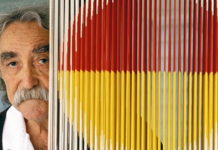Frank Stella is an American artist best known for his use of geometric patterns and shapes in creating both paintings and sculptures. Arguably one of the most influential living American artists, Stella’s works utilize the formal properties of shape, color, and composition to explore non-literary narratives, as seen in his work Harrar II (1967) from the Protractor series. “Abstraction didn’t have to be limited to a kind of rectilinear geometry or even a simple curve geometry. It could have a geometry that had a narrative impact. In other words, you could tell a story with the shapes,” he explained. “It wouldn’t be a literal story, but the shapes and the interaction of the shapes and colors would give you a narrative sense. You could have a sense of an abstract piece flowing along and being part of an action or activity.” Born on May 12, 1936 in Malden, MA, Stella went on to study history at Princeton University before moving to New York in 1958. Having moved to the city, Stella was immersed in the heyday Abstract Expressionism, but it was the work of Jasper Johns that inspired Stella’s Black Paintings of 1958-1960. These flatly painted, austere works, helped open up the doors to Minimalism. Through the following decades, Stella gained traction in the art world and in 1970 he became the youngest artist ever to be granted a solo exhibition at The Museum of Modern Art. He continues to work in New York, NY and commutes to his studio in Rock Tavern, New York. Today, Stella’s works are held in the collections of the Metropolitan Museum of Art in New York, the Kunstmuseum Basel, the Art Institute of Chicago, the National Gallery of Art in Washington, D.C., and the Tate Gallery in London, among others.
Stella’s art was recognized for its innovations before he was twenty-five. In 1959, several of his paintings were included in Three Young Americans at the Allen Memorial Art Museum at Oberlin College, as well as in Sixteen Americans at the Museum of Modern Art in New York (1959–60). Stella joined dealer Leo Castelli’s stable of artists in 1959. In his early series, including the Black Paintings (1958–60), Aluminum Paintings (1960), and Copper Paintings (1960–61), Stella cast aside illusionistic space for the physicality of the flat surface and deviated from the traditional rectangular-shaped canvas. Stella married Barbara Rose, later a well-known art critic, in 1961.
Stella’s Irregular Polygon canvases (1965–67) and Protractor series (1967–71) further extended the concept of the shaped canvas. Stella began his extended engagement with printmaking in the mid-1960s, working first with master printer Kenneth Tyler at Gemini G.E.L. In 1967, Stella designed the set and costumes for Scramble, a dance piece by Merce Cunningham. The Museum of Modern Art in New York presented a retrospective of Stella’s work in 1970. During the following decade, Stella introduced relief into his art, which he came to call “maximalist” painting for its sculptural qualities. Ironically, the paintings that had brought him fame before 1960 had eliminated all such depth. After introducing wood and other materials in the Polish Village series (1970–73), created in high relief, he began to use aluminum as the primary support for his paintings. As the 1970s and 1980s progressed, these became more elaborate and exuberant. Indeed, his earlier Minimalism became baroque, marked by curving forms, DayGlo colors, and scrawled brushstrokes. Similarly, his prints of these decades combined various printmaking and drawing techniques. In 1973, he had a print studio installed in his New York house.
From the mid-1980s to the mid-1990s, Stella created a large body of work that responded in a general way to Herman Melville’s Moby Dick. During this time, the increasingly deep relief of Stella’s paintings gave way to full three-dimensionality, with sculptural forms derived from cones, pillars, French curves, waves, and decorative architectural elements. To create these works, the artist used collages or maquettes that were then enlarged and re-created with the aid of assistants, industrial metal cutters, and digital technologies.
In the 1990s, Stella began making freestanding sculpture for public spaces and developing architectural projects. In 1992–93, for example, he created the entire decorative scheme for Toronto’s Princess of Wales Theatre, which includes a 10,000-square-foot mural. His 1993 proposal for a kunsthalle (arts center) and garden in Dresden did not come to fruition. His aluminum bandshell, inspired by a folding hat from Brazil, was built in downtown Miami in 1999. In 2001, a monumental Stella sculpture was installed outside the National Gallery of Art in Washington, D.C.
Stella’s work was included in several important exhibitions that defined 1960s art, among them the Solomon R. Guggenheim Museum’s The Shaped Canvas (1964–65) and Systemic Painting (1966). His art has been the subject of several retrospectives in the United States, Europe, and Japan. Among the many honors he has received was an invitation from Harvard University to give the Charles Eliot Norton lectures in 1983–84. Calling for a rejuvenation of abstraction by achieving the depth of baroque painting, these six talks were published by Harvard University Press in 1986. The artist continues to live and work in New York.
Frank Stella, an iconic figure of postwar American art, is considered the most influential painter of a generation that moved beyond Abstract Expressionism toward Minimalism. In his early work, Stella attempted to drain any external meaning or symbolism from painting, reducing his images to geometric form and eliminating illusionistic effects. His goal was to make paintings in which pictorial force came from materiality, not from symbolic meaning. He famously quipped, “What you see is what you see,” a statement that became the unofficial credo of Minimalist practice. In the 1980s and ’90s, Stella turned away from Minimalism, adopting a more additive approach for a series of twisting, monumental, polychromatic metal wall reliefs and sculptures based on Herman Melville’s Moby Dick.
Frank Stella biography
Frank Stella, in full Frank Philip Stella, (born May 12, 1936, Malden, Massachusetts, U.S.), American painter who began as a leading figure in the Minimalist art movement and later became known for his irregularly shaped works and large-scale multimedia reliefs.
Stella studied painting at the Phillips Academy in Andover, Massachusetts, and history at Princeton University (B.A., 1958). He originally painted in an Abstract Expressionist style, but, upon moving to New York City in the late 1950s, he began work on a series of innovative paintings marked by an austere and monumental simplicity of design. The “black paintings,” which established his reputation, incorporated symmetrical series of thin white stripes that replicated the canvas shape when seen against their black backgrounds. Those works—e.g., The Marriage of Reason and Squalor, II (1959)—were included in the landmark exhibition “Sixteen Americans” at New York City’s Museum of Modern Art (MoMA) in 1959–60. He had his first solo exhibition in 1960 at the Leo Castelli Gallery, also in New York City. In the early 1960s Stella painted a series of progressively more complex variations on the theme of the frame-determined design and used both metallic-coloured paints and irregularly shaped canvases to that purpose. Stella expanded his use of colour in the Protractor series (1967–71), an influential group of paintings marked by intersecting geometric and curvilinear shapes and plays of vivid and harmonious colours, some of which were fluorescent.
Stella’s next decade opened with a survey of his work at MoMA (1970). In the late 1970s Stella broke with the hard-edged style of his previous work and began to produce sensuously coloured mixed-media reliefs that featured arabesques, French curves, and other organic shapes. His two-dimensional works became increasingly three-dimensional during the late 1970s and early 1980s and began to incorporate architectural forms made from materials such as aluminum and fibreglass. In the mid-1980s he embarked on a major project that took its title from and was based on Herman Melville’s Moby Dick. Between 1985 and 1997 Stella created some 260 pieces in the series, including prints, sculptures, and reliefs named after chapters in Melville’s novel. MoMA held another retrospective of his work in 1987.
In the 1990s Stella began to create freestanding sculptures—e.g., Raft of the Medusa (Part I), (1990). Some of them—such as Prinz Friedrich von Homburg, Ein Schauspiel, 3X (1998–2001), a 31-foot (9.4-metre) mixed-media sculpture installed in front of the National Gallery of Art in Washington, D.C.—were public art commissions. About this time he also began to experiment with star forms in a variety of sizes and finishes. Some were freestanding (Fat 12 Point Carbon Fiber Star [2016] and Jasper’s Split Star [2017]), but others were attached to another sculpture (Inflated Star and Wooden Star [2014]). In 2015 the Whitney Museum of American Art celebrated his long career with a major retrospective covering 60 years of his work.
Source: https://www.britannica.com/biography/Frank-Stella













